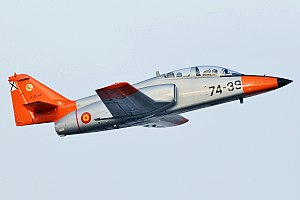CASA C-101 Aviojet
You can help expand this article with text translated from the corresponding article in Spanish. (February 2013) Click [show] for important translation instructions.
|
| C-101 Aviojet | |
|---|---|

| |
| Spanish Air Force C-101 | |
| Role | Advanced jet trainer and light attack aircraft |
| Manufacturer | CASA |
| First flight | 27 June 1977[1] |
| Introduction | 17 March 1980[1] |
| Status | Operational |
| Primary users | Spanish Air Force Chilean Air Force Honduran Air Force Royal Jordanian Air Force |
| Number built | 166 |





The CASA C-101 Aviojet is a low-wing single engine jet-powered advanced trainer and light attack aircraft. It remains in service in the Spanish Air Force and some other countries; it is also flown by the Patrulla Aguila aerobatics team.
It was designed to replace the already outdated Hispano Saeta. Spanish aircraft maker CASA began work on the C-101 in 1975. Germany's MBB and the USA's Northrop helped with the development, and the first four prototypes flew in June 1977. The design followed that of other jet trainers such as the BAE Hawk and the Alpha Jet, but was less aerodynamically sophisticated, with an unswept wing, and it had limited weapons capability.[2]
Design and development
The aircraft was designed in response to a Spanish Air Force requirement in 1975 for a jet trainer to replace its aging fleet of Hispano HA-200s and Ha.220s. Like many European jet trainers, it was also to have a limited attack capability. CASA sought technical assistance from Messerschmitt-Bölkow-Blohm (MBB) and Northrop, the latter designing the wings.[3] A design along largely conventional lines was the result, the only surprising feature being a large internal weapons bay beneath the rear cockpit, allowing for a wider variety of armament to be carried than the underwing pylons alone would allow. Alternatively, this bay can be used to carry reconnaissance equipment. The aircraft is designed in a modular fashion to ease manufacturing and maintenance, and enjoys a great range since its initial requirement called for autodeployment to the Canary Islands from the Spanish mainland.
Although the first flight took place on 27 June 1977,[1] test flights did not begin until 17 April 1978.[citation needed] Performance was found to be better than anticipated by the designers. An initial Spanish Air Force order for 88 machines was placed, a dedicated trainer version designated C-101EB-01 by CASA and E.25 Mirlo ("Blackbird") by the air force. The first aircraft entered service on 17 March 1980.
This was followed in production by a combination attack/trainer with an uprated engine designated C-101BB-02 bought by Honduras, which bought four, and Chile, which bought four aircraft and parts for another eight to be assembled locally by ENAER. All Chilean BB-02s are designated T-36 Halcón.
In 1983, CASA flew a dedicated attack version, the C-101CC-02, which was again ordered by Chile. This time, only the prototype was built in Spain, with the remaining 22 machines built by ENAER. This variant features yet another engine upgrade and increased fuel capacity and is designated A-36 Halcón ("Falcon").
Sixteen similar aircraft, the C-101CC-04 were sold to Jordan.
The final version of the C-101, the C-101DD was demonstrated by CASA in 1985, featuring vastly improved avionics and the capability to carry the AGM-65 Maverick air-to-ground missile, but failed to attract any orders.
In the 1990s the armament system was modernized.
Operators
- Chilean Air Force (35 -12 C-101BB and 23 C-101CC)
- Honduran Air Force (4 C-101BB) These aircraft scored several kills against drug smuggling aircraft
- Jordanian Air Force (16 C-101CC)
- Spanish Air Force (88 C-101EB)
Specifications (CASA C-101EB)
Data from {name of first source}
General characteristics
- Crew: Two (student and instructor)
Performance
- Thrust/weight: 1:3.2 (3.16 N/kg)
- Maximum G: +7.5 -3.9
Armament
- 1 – 30 mm DEFA cannon or 2 – 12.7 mm (.50 cal) M3 machine guns in detachable pods underneath the forward fuselage
- Up to 2,220 kg (4,890 lb) disposable stores on 6 underwing pylons
- 2 – Rafael Shafrir (A-36 "Toqui") air-to-air missiles
See also
Aircraft of comparable role, configuration, and era
- Aero L-39 Albatros
- Aermacchi MB-339
- AIDC AT-3
- BAE Systems Hawk
- Dassault/Dornier Alpha Jet
- FMA IA 63 Pampa
- IAR 99
- Kawasaki T-4
- Soko G-4 Super Galeb
Related lists
References
- ^ a b c Taylor 1982, p. 180.
- ^ Jackson, Robert (2011). Aircraft from 1914 to the present day. p. 175. ISBN 978-1-907446-02-3.
- ^ Frawley, Gerard (2002). The International Directory of Military Aircraft, 2002–2003. Fyshwick, ACT, Australia: Aerospace Publications Pty Ltd. p. 58. ISBN 1-875671-55-2.
- Taylor, John W. R. (1982). Jane's All the World's Aircraft 1982–83. London: Jane's Yearbooks. ISBN 0-7106-0748-2.
